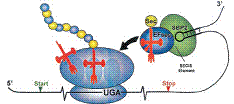Biochemistry, Department of

Vadim Gladyshev Publications
Document Type
Article
Date of this Version
October 2006
Abstract
Background: Selenocysteine (Sec) is co-translationally inserted into protein in response to UGA codons. It occurs in oxidoreductase active sites and often is catalytically superior to cysteine (Cys). However, Sec is used very selectively in proteins and organisms. The wide distribution of Sec and its restricted use have not been explained. Results: We conducted comparative genomics and phylogenetic analyses to examine dynamics of Sec decoding in bacteria at both selenium utilization trait and selenoproteome levels. These searches revealed that 21.5% of sequenced bacteria utilize Sec, their selenoproteomes have 1 to 31 selenoproteins, and selenoprotein-rich organisms are mostly Deltaproteobacteria or Firmicutes/ Clostridia. Evolutionary histories of selenoproteins suggest that Cys-to-Sec replacement is a general trend for most selenoproteins. In contrast, only a small number of Sec-to-Cys replacements were detected, and these were mostly restricted to formate dehydrogenase and selenophosphate synthetase families. In addition, specific selenoprotein gene losses were observed in many sister genomes. Thus, the Sec/Cys replacements were mostly unidirectional, and increased utilization of Sec by existing protein families was counterbalanced by loss of selenoprotein genes or entire selenoproteomes. Lateral transfers of the Sec trait were an additional factor, and we describe the first example of selenoprotein gene transfer between archaea and bacteria. Finally, oxygen requirement and optimal growth temperature were identified as environmental factors that correlate with changes in Sec utilization. Conclusion: Our data reveal a dynamic balance between selenoprotein origin and loss, and may account for the discrepancy between catalytic advantages provided by Sec and the observed low number of selenoprotein families and Sec-utilizing organisms.


Comments
Published by Genome Biology 2006, 7:R94. © 2006 Zhang et al.; licensee BioMed Central Ltd. Permission to use. http://genomebiology.com/2006/7/10/R94.